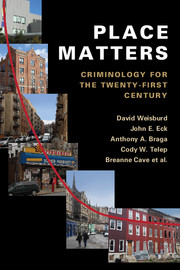Book contents
- Frontmatter
- Contents
- List of figures
- List of tables
- List of contributors
- Preface
- 1 Crime Places within Criminological Thought
- 2 The Concentration of Crime at Place
- 3 Theories of Crime and Place
- 4 The Importance of Place in Mainstream Criminology and Related Fields: Influences and Lessons to be Learned
- 5 Methods of Place-Based Research
- 6 Reducing Crime at High-Crime Places: Practice and Evidence
- 7 Crime Places in the Criminological Imagination
- Notes
- References
- Index
3 - Theories of Crime and Place
Published online by Cambridge University Press: 05 April 2016
- Frontmatter
- Contents
- List of figures
- List of tables
- List of contributors
- Preface
- 1 Crime Places within Criminological Thought
- 2 The Concentration of Crime at Place
- 3 Theories of Crime and Place
- 4 The Importance of Place in Mainstream Criminology and Related Fields: Influences and Lessons to be Learned
- 5 Methods of Place-Based Research
- 6 Reducing Crime at High-Crime Places: Practice and Evidence
- 7 Crime Places in the Criminological Imagination
- Notes
- References
- Index
Summary
In the previous chapter, we showed that crime is concentrated at very small geographic units, substantially smaller than neighborhoods, and that these concentrations, on average, are relatively stable. This is true whether examining high- or low-crime neighborhoods. Although high-crime places do cluster, they seldom form a homogeneous block of high-crime places. Rather, interspersed within concentrations of high-crime places are many low- and modest-crime places.
Why is crime concentrated in a relatively small number of places? Standard criminology has not asked this question, largely because standard criminology focuses on criminality and implicitly assumes that the density of offenders explains crime density. Recognition that place characteristics matter is the starting point for this chapter. We look at two perspectives on crime place characteristics. We use the term “perspective” because each type of explanation is comprised of multiple theories linked by a common orientation. The first perspective arises from opportunity theories of crime. The second perspective arises from social disorganization theories of crime.
We begin by contrasting two ways of thinking about how a place becomes a crime hot spot and suggest that the process by which high-crime places evolve must involve place characteristics. In the next sections, we examine opportunity and social disorganization explanations. In the final section of the chapter, we examine possible ways researchers might link these two perspectives.
PROCESSES THAT CREATE CRIME PLACES
Before we look for explanations of why places become hot spots of crime it is important to consider two processes that might lead to such an outcome. Criminologists have generally proposed two generic models to account for the processes that lead to variation in place susceptibility to crime. One model suggests that places may start with reasonably similar risks of an initial criminal attack, but once attacked the risk of a subsequent attack on the place rises. Over time, places diverge in their crime risk, and consequently in their crime counts. This temporal contagion model is also known as a boost model (see Chapter 2) or a state-dependence model. It puts the emphasis on offenders’ willingness to return to a previously successful crime site (Johnson et al. 2007; Townsley et al. 2000). It suggests that irrespective of initial crime risk the occurrence of a crime will lead to changes in risk of crime at a place.
- Type
- Chapter
- Information
- Place MattersCriminology for the Twenty-First Century, pp. 42 - 67Publisher: Cambridge University PressPrint publication year: 2016

